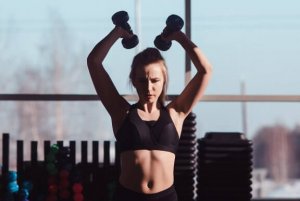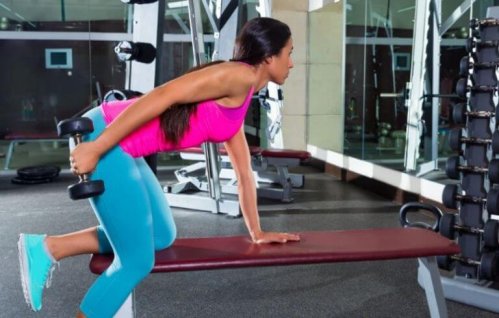Six Reasons to Make Sure You Train the Upper Body

Training the upper body may be the only reason most men go to the gym. However, for women, it’s quite the opposite; they tend to mostly work their legs. In this article, we’ll talk about the reasons why it’s important to train your upper body, that includes your arms, shoulders, and back.
Why should I train my upper body?
You intentionally try to avoid going to the gym on the days that you have to work out the upper body. And so, oftentimes we look for excuses to not do something when we know that it’s actually good for our health.
Also, some women fear hypertrophy or worry they’ll look too muscular and less feminine. However, working all the muscles in the body is necessary. Here are some of the benefits:
1. Spine balance
Having a strong upper body will help you to avoid back pain because these muscles support your spine. And so, the best exercises to avoid back pain are those that focus on the arms, shoulders, trapezoids, dorsal and lumbar areas.
One of the causes of back, neck, and shoulder pain is a weak upper body. Therefore, it generates inbalance in everyday postures.
2. The body is a complete system
The body works together as a whole system, so we can’t ignore the upper body and only work the legs. Of course, there are areas where we want to emphasize the exercise to look better. However, that doesn’t mean that we can forget about the rest of the body.
Thus, we recommend that at least a third of your exercise routine is focused on your upper body. Additionally, we can take advantage of certain visual tricks that will help you to look better. For example, if your shoulders and back are toned, it’ll make your waistline look thinner by comparison.
3. Muscular balance
While considering the previous points, keep in mind that the body needs a certain degree of balance. In other words, it’s not acceptable, or healthy, to have some weak areas and some strong areas. If that were the case, you would start feeling some discomfort in those underdeveloped areas.

If over time you neglect to exercise the upper body, you could experience certain discomforts and pain in the shoulders, back, wrists and neck.
4. Improve flexibility
In order to perform certain sports and even mundane everyday activities, you need some flexibility. Therefore, we must work on upper body flexibility to avoid injuries and uncomfortable pains.
The best way to improve your flexibility is to train and stretch after training. Furthermore, when our muscles are more elastic, we protect our joints and avoid injuries and muscle cramps.
5. Faster metabolism
In case you want to lose weight, you must know that your metabolism plays a large role here. If you increase your muscle mass, you will also increase the calorie use in the body.
However, keep in mind that we’re not just referring to muscle mass in the legs and glutes, we mean the whole body, including the upper body. There are many muscle groups in the arms, back, chest, and shoulders, and working them can help by accelerating your metabolism.
6. Toned arms are also part of a feminine figure
Set aside those fears and misconceptions about the arms, having toned arms will not make you look masculine. Every day there are more and more women who work their upper bodies in order to look great in any attire.

We don’t need to reach hypertrophy when working out the upper body. It’s more about having a fit body with less body fat and more strength. If you do this, you’ll look better and maintain your feminine figure.
If you’re still not convinced by these great reasons to work out the upper body, keep in mind that it might be a good use of a leg rest day. Finally, you will feel better when gaining more upper body strength since it will help you to perform everyday tasks more easily.
Training the upper body may be the only reason most men go to the gym. However, for women, it’s quite the opposite; they tend to mostly work their legs. In this article, we’ll talk about the reasons why it’s important to train your upper body, that includes your arms, shoulders, and back.
Why should I train my upper body?
You intentionally try to avoid going to the gym on the days that you have to work out the upper body. And so, oftentimes we look for excuses to not do something when we know that it’s actually good for our health.
Also, some women fear hypertrophy or worry they’ll look too muscular and less feminine. However, working all the muscles in the body is necessary. Here are some of the benefits:
1. Spine balance
Having a strong upper body will help you to avoid back pain because these muscles support your spine. And so, the best exercises to avoid back pain are those that focus on the arms, shoulders, trapezoids, dorsal and lumbar areas.
One of the causes of back, neck, and shoulder pain is a weak upper body. Therefore, it generates inbalance in everyday postures.
2. The body is a complete system
The body works together as a whole system, so we can’t ignore the upper body and only work the legs. Of course, there are areas where we want to emphasize the exercise to look better. However, that doesn’t mean that we can forget about the rest of the body.
Thus, we recommend that at least a third of your exercise routine is focused on your upper body. Additionally, we can take advantage of certain visual tricks that will help you to look better. For example, if your shoulders and back are toned, it’ll make your waistline look thinner by comparison.
3. Muscular balance
While considering the previous points, keep in mind that the body needs a certain degree of balance. In other words, it’s not acceptable, or healthy, to have some weak areas and some strong areas. If that were the case, you would start feeling some discomfort in those underdeveloped areas.

If over time you neglect to exercise the upper body, you could experience certain discomforts and pain in the shoulders, back, wrists and neck.
4. Improve flexibility
In order to perform certain sports and even mundane everyday activities, you need some flexibility. Therefore, we must work on upper body flexibility to avoid injuries and uncomfortable pains.
The best way to improve your flexibility is to train and stretch after training. Furthermore, when our muscles are more elastic, we protect our joints and avoid injuries and muscle cramps.
5. Faster metabolism
In case you want to lose weight, you must know that your metabolism plays a large role here. If you increase your muscle mass, you will also increase the calorie use in the body.
However, keep in mind that we’re not just referring to muscle mass in the legs and glutes, we mean the whole body, including the upper body. There are many muscle groups in the arms, back, chest, and shoulders, and working them can help by accelerating your metabolism.
6. Toned arms are also part of a feminine figure
Set aside those fears and misconceptions about the arms, having toned arms will not make you look masculine. Every day there are more and more women who work their upper bodies in order to look great in any attire.

We don’t need to reach hypertrophy when working out the upper body. It’s more about having a fit body with less body fat and more strength. If you do this, you’ll look better and maintain your feminine figure.
If you’re still not convinced by these great reasons to work out the upper body, keep in mind that it might be a good use of a leg rest day. Finally, you will feel better when gaining more upper body strength since it will help you to perform everyday tasks more easily.
All cited sources were thoroughly reviewed by our team to ensure their quality, reliability, currency, and validity. The bibliography of this article was considered reliable and of academic or scientific accuracy.
- Marcano, L. H. (2013). Prevención del dolor de espalda en el ámbito laboral. Revista Enfermería C y L. https://doi.org/10.1016/S0378-7788(03)00056-2
This text is provided for informational purposes only and does not replace consultation with a professional. If in doubt, consult your specialist.








